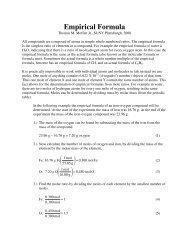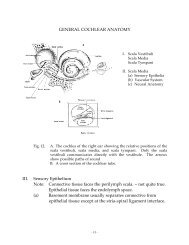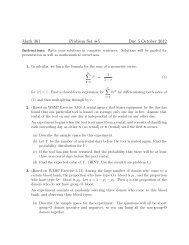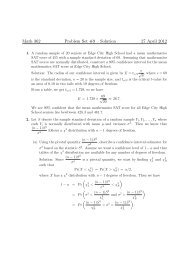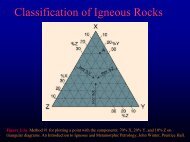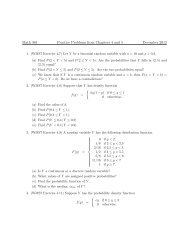A note on the complexity of Graphs - Faculty web pages
A note on the complexity of Graphs - Faculty web pages
A note on the complexity of Graphs - Faculty web pages
Create successful ePaper yourself
Turn your PDF publications into a flip-book with our unique Google optimized e-Paper software.
A NOTE ON THE COMPLEXITY OF GRAPHSSam NorthshieldSUNY-College at Plattsburgh and University <strong>of</strong> MinnesotaAbstract. The number <strong>of</strong> splanning trees in a finite graph is first expressed as<strong>the</strong> derivative (at 1) <strong>of</strong> a determinant and <strong>the</strong>n in terms <strong>of</strong> a zeta functi<strong>on</strong>. Thisgeneralizes a result <strong>of</strong> Hashimoto to n<strong>on</strong>-regular graphs.Let G be a finite graph. The <strong>complexity</strong> <strong>of</strong> G, de<str<strong>on</strong>g>note</str<strong>on</strong>g>d κ, is <strong>the</strong> number <strong>of</strong>spanning trees in G. This quantity has l<strong>on</strong>g been known to be related to matricesassociated with G (see [1]). When G is regular, Hashimoto [2] expressed κ as alimit involving <strong>the</strong> zeta functi<strong>on</strong> <strong>of</strong> <strong>the</strong> graph and asked if his expressi<strong>on</strong> still holdsfor irregular graphs. In this <str<strong>on</strong>g>note</str<strong>on</strong>g>, we show that <strong>the</strong> answer is yes. In particular,we derive a formula for <strong>the</strong> <strong>complexity</strong> as <strong>the</strong> derivative <strong>of</strong> a determinant involving<strong>the</strong> adjacency matrix <strong>of</strong> <strong>the</strong> graph and use this and a generalized versi<strong>on</strong> <strong>of</strong> Ihara’s<strong>the</strong>orem ([3,4]) to get <strong>the</strong> desired result.Let G be a graph with ν vertices and ε edges. Suppose we order <strong>the</strong> vertices:(x 1 , . . . , x ν ). The adjacency matrix A = (a ij ) is <strong>the</strong> matrix <strong>of</strong> zeros and <strong>on</strong>es suchthat a ij = 1 if and <strong>on</strong>ly if x i and x j are adjacent. We let D = (d ij ) be <strong>the</strong> diag<strong>on</strong>alelement with d ii = d i − 1 where d i is <strong>the</strong> degree <strong>of</strong> <strong>the</strong> vertex x i . Finally, letQ = D − I. For a complex variable u, letTheorem. f ′ (1) = 2(ɛ − ν)κ.f(u) = det(I − uA + u 2 Q).Pro<strong>of</strong>. Let M u = I − uA + u 2 Q and let M u k = (mu k;ij ) de<str<strong>on</strong>g>note</str<strong>on</strong>g> <strong>the</strong> matrix M u wi<strong>the</strong>ach entry <strong>of</strong> <strong>the</strong> k th row replaced by its corresp<strong>on</strong>ding derivative with respect tou. Thendet(M u ) ′ = ∑ π= ∑ jsgn(π)( ∏ i∑sgn(π) ∏πim u iπ(i) )′m u j;iπ(i) = ∑ jdet(M u j ).Note that m 1 k;ij = d iδ ij − a ij + (d k − 2)δ ki δ ij , and thusf ′ (1) = ∑ kdet(M + (d k − 2)R k )This <str<strong>on</strong>g>note</str<strong>on</strong>g> was written while <strong>the</strong> author was <strong>on</strong> sabbatical leave at <strong>the</strong> University <strong>of</strong> Minnesota.The author appreciated <strong>the</strong> hospitality <strong>of</strong> <strong>the</strong> math department during that time.1Typeset by AMS-TEX
2 SAM NORTHSHIELDwhere M = M 1 and R k = (r k;ij ) is defined by r k:ij = δ ki δ ij .In general,if ˜m ij is <strong>the</strong> c<strong>of</strong>actor <strong>of</strong> m ij in M, <strong>the</strong>ndet(M + cR k ) = ∑ j(M + cR k ) kj (−1) j+k ˜m kj= ∑ jm kj (−1) j+k ˜m kj + c ˜m kk = c ˜m kk(since det(M) = 0). By Biggs ([1], <strong>the</strong>orem 6.3), ˜m ij = κ for all i and j and thusf ′ (1) = κ ∑ k (d k − 2) = 2(ɛ − ν)κ. □We define <strong>the</strong> zeta functi<strong>on</strong> <strong>of</strong> G to beZ(u) = ∏ i(1 − u ω i) −1where (ω 1 , ω 2 , . . . ) are <strong>the</strong> lengths <strong>of</strong> prime cycles in G (see [3] or [4] for definiti<strong>on</strong>s).A generalizati<strong>on</strong> <strong>of</strong> a <strong>the</strong>orem <strong>of</strong> Ihara’s is thatZ(u) =1(1 − u 2 ) ɛ−ν f(u)(see [3] or [4]). The following generalizati<strong>on</strong> <strong>of</strong> [2; <strong>the</strong>orem 7.7] is immediate.Corollary. lim u→1 − Z(u)(1 − u) ɛ−ν+1 = − 2−ɛ+ν−1(ɛ−ν)κ .References1. N. Biggs, Algebraic Graph Theory, Cambridge University Press, Cambridge, 1974.2. K. Hashimoto, Zeta Functi<strong>on</strong>s <strong>of</strong> Finite <strong>Graphs</strong> and Representati<strong>on</strong>s <strong>of</strong> p-Adic Groups, AdvancedStudy in Pure Math., vol. 15, Academic Press, NY, 1989, pp. 211-280.3. S. Northshield, Several pro<strong>of</strong>s <strong>of</strong> Ihara’s <strong>the</strong>orem, IMA Preprint Series no. 1459.4. H.M. Stark and A.A. Terras, Zeta functi<strong>on</strong>s <strong>of</strong> finite graphs and coverings, Adv. Math. 121(1996), no. 1, 124–165.



